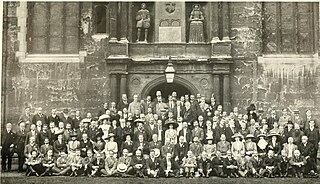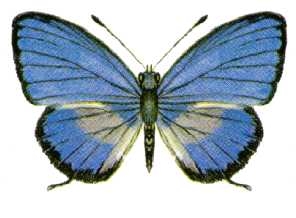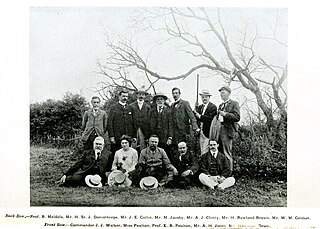
The superfamily Papilionoidea contains all the butterflies except for the moth-like Hedyloidea.

Lycaenidae is the second-largest family of butterflies, with over 6,000 species worldwide, whose members are also called gossamer-winged butterflies. They constitute about 30% of the known butterfly species.

Riodinidae is the family of metalmark butterflies. The common name "metalmarks" refers to the small, metallic-looking spots commonly found on their wings. The 1,532 species are placed in 146 genera. Although mostly Neotropical in distribution, the family is also represented both in the Nearctic, Palearctic, Australasian (Dicallaneura), Afrotropic, and Indomalayan realms.

Lycaeninae, the coppers, are a subfamily of the gossamer-winged butterflies (Lycaenidae).

Miletinae is a subfamily of the family Lycaenidae of butterflies, commonly called harvesters and woolly legs, and virtually unique among butterflies in having predatory larvae. Miletinae are entirely aphytophagous. The ecology of the Miletinae is little understood, but adults and larvae live in association with ants, and most known species feed on Hemiptera, though some, like Liphyra, feed on the ants themselves. The butterflies, ants, and hemipterans, in some cases, seem to have complex symbiotic relationships benefiting all.

Allotinus is a genus of butterflies in the family Lycaenidae. The genus was erected by Cajetan Felder and Rudolf Felder in 1865. The members (species) of this genus are found in the Indomalayan realm.

Polyommatinae, the blues, are a diverse subfamily of gossamer-winged butterflies.

Polyommatini is a tribe of lycaenid butterflies in the subfamily of Polyommatinae. These were extensively studied by Russian novelist and lepidopterist Vladimir Nabokov.

The Theclini are a tribe of butterflies in the family Lycaenidae. As not all Theclinae have been assigned to tribes, the genus list is preliminary.

The Aphnaeinae are a subfamily of butterflies in the family Lycaenidae.

The scarce large blue is a species of butterfly in the family Lycaenidae. It is found in Austria, Slovenia, Croatia, the Czech Republic, France, Georgia, Germany, Hungary, Italy, Japan, Kazakhstan, Mongolia, the Netherlands, Poland, Romania, Russia, northern Serbia, Spain, Switzerland, and Ukraine and East across the Palearctic to Japan. The species was first described by Johann Andreas Benignus Bergsträsser in 1779.

Evenus is a butterfly genus in the family Lycaenidae, with species ranging from North to South America.

Lachnocnema, commonly called woolly legs, is a genus of butterflies in the family Lycaenidae found mainly in Sub-Saharan Africa. Identification requires dissection to reveal subtle genital distinctions.

George Thomas Bethune-Baker was an English entomologist who specialised in Lepidoptera, especially those in the family Lycaenidae of butterflies.

Tajuria is an Indomalayan genus of butterflies in the family Lycaenidae.

Nacaduba cyanea, the tailed green-banded line-blue, is a species of butterfly in the family Lycaenidae, and formerly considered a member of the genus Danis. It is found in the Indonesia, Papua New Guinea, the Solomon Islands and Australia (Queensland).

Hamilton Herbert Charles James Druce was an English entomologist who specialised in Lycaenidae and to a lesser extent Hesperiidae. He is not to be confused with his father, the English entomologist Herbert Druce (1846–1913) who also worked on Lepidoptera.
Henri Stempffer was a French entomologist who specialized in the study of Lycaenidae butterflies.
Lieutenant-Colonel Thomas Herbert Elliot Jackson was an English coffee farmer in Kenya. He served as an officer in the British Army during the Second World War, seeing service with the King's African Rifles and as a military administrator in British Somaliland. Jackson served in the Kenyan colonial administration during the Mau Mau Rebellion.

















